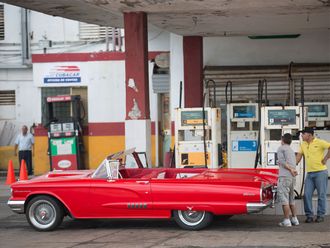New York, London: Aspirational luxury’s in search of its lost bling. With the shine coming off gold-plated sellers like Burberry and Cartier-owner Richemont, it’s reasonable to focus on the prospects for Pandora, Michael Kors, Kate Spade, and other so-called affordable luxury players. In years past these labels have managed to lure shoppers who covet brand-name purses, jewellery, and shoes, but are only interested in more-palatable price points.
You might think that, if global currency swings and economic uncertainty cause big spenders to pause on purchases of $3,500 (Dh12,845) Prada purses, they might still splurge on a $500 Kate Spade handbag. Indeed, shares of some accessible-luxury brands have outperformed their higher-end peers this year.
But that’s not how luxury works. The ultra-rich who fancy a new top-line Gucci or Louis Vuitton handbag aren’t inclined to trade down.
Meanwhile, more cost-conscious consumers, who are more likely to be worried about losing their jobs than the super-rich when times get tough, are staying away. And it’s going to be harder to crack the value mindset of millennials, the favoured target of many of these labels, according to analysts at Bernstein.
Ubiquity and overexposure are the enemy of luxury, and some US labels are also fighting to re-engage shoppers after a swelling of retail locations, an outlet building boom, and an increased reliance on discounts drove them away.
In a rare occurrence, Pandora came up short of analysts’ sales and profit estimates. The Danish jewellery maker had ridden a wave of demand that made it the second-best performing stock last year in Bloomberg Intelligence’s luxury peer group, but this time falling same-store sales in Brazil, Canada and the Caribbean led to a miss. It’s hard to see a crisis brewing with 20 per cent second-quarter sales growth, but the hiccup is a red flag for luxury investors.
It was a similar picture at Michael Kors, where comparable sales fell 7.6 per cent from a year earlier, more than the already-depressed estimate for a 4.6 per cent drop. A decline in mall traffic and tourism, as well as a flurry of discounts at department stores, led the company to cut its full-year sales forecast.
To regain cachet and maintain profit amid declining shopper traffic, companies like Kors, Ralph Lauren and Coach are slashing promotions and pulling goods from downmarket department stores. They’re also culling lower-priced products and trying to introduce higher-quality goods, such as monogrammed leather bags.
Coach said that this strategy is helping. Its bags and other products priced at more than $400 made up 40 per cent of fourth-quarter sales, up from 30 per cent the year before, and it posted annual sales growth at its own stores for the first time in more than three years. That still wasn’t enough for a punchy revenue forecast for 2017 — instead, the company offered a pace of low-to-mid-single digit percentage growth.
But clambering up market doesn’t always work. Take British luxury brand Mulberry. It sought to take its handbags more upscale, but failed to inject sufficient style and quality to justify those fatter price tags. While it lacked the credibility to play in the highest luxury echelons, it also neglected its core customers. The result was a string of profit warnings and the ouster of its chief executive.
Meanwhile, increased competition is coming. Newer contemporary brands like Mansur Gavriel and Clare V. are making inroads with younger fashion shoppers. And higher-end luxury brands, such as Prada, are introducing some lower price points to attract both local shoppers and the less-well-off Chinese consumers who have now started to travel.
Affordable luxury can expect an unseemly crush to stay ahead.












